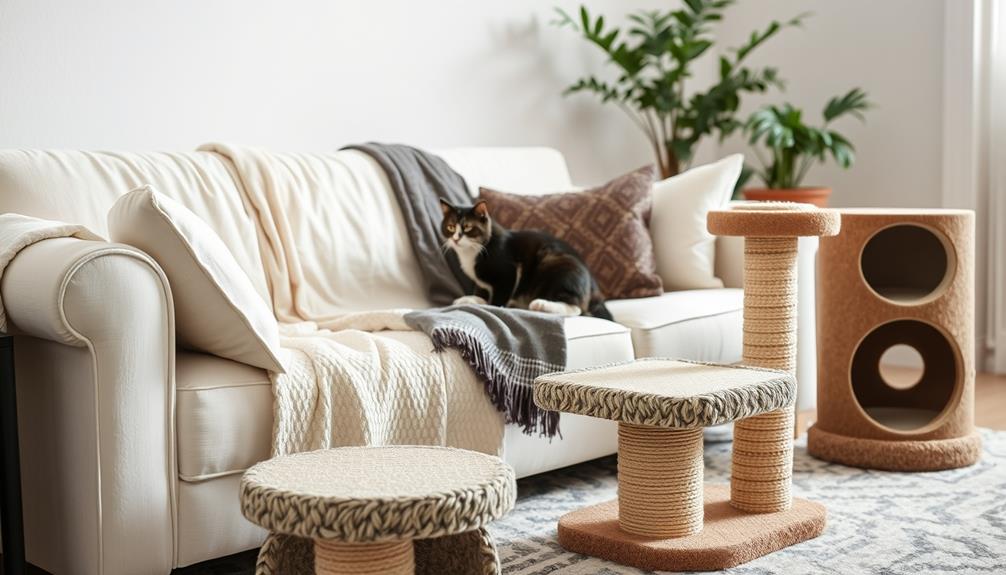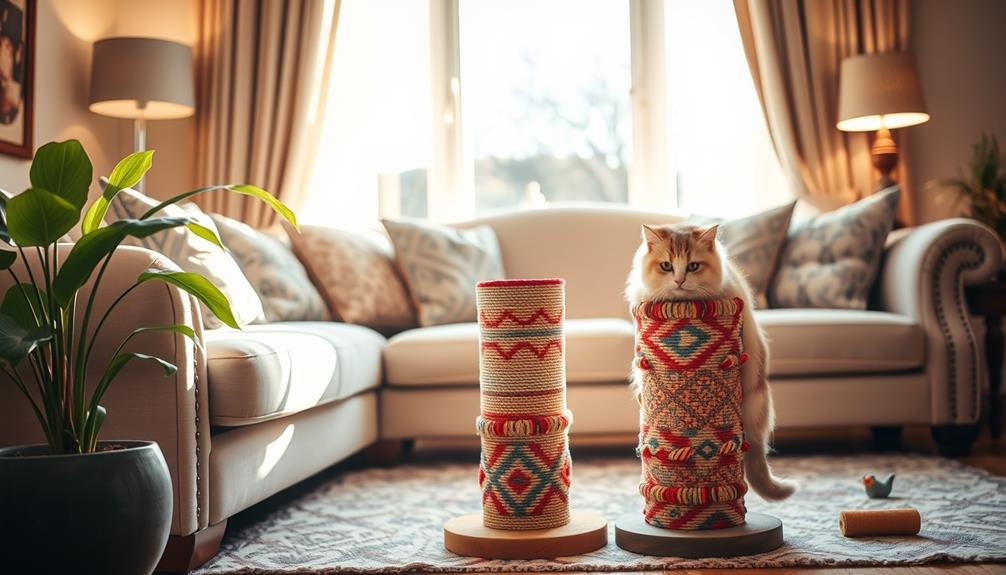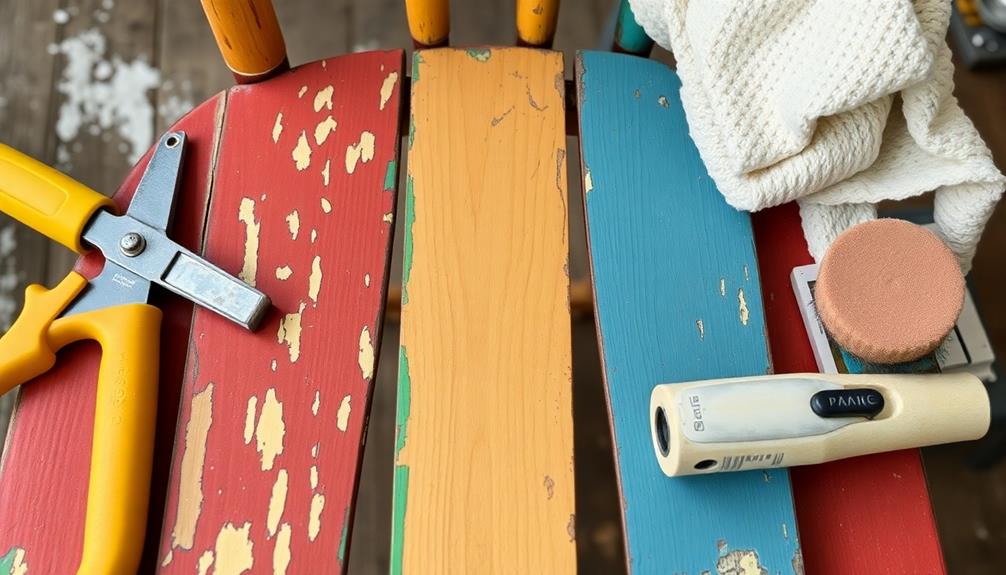In order to prevent your cat from scratching furniture, it is important to first understand their natural instincts. Providing multiple scratching posts made from sisal or wood and placing them near your cat’s favorite spots can help. Using positive reinforcement such as treats or praise can encourage your cat to use these posts instead of your furniture. To make furniture less appealing, you can cover surfaces with double-sided tape or protective blankets. Environmental enrichment like toys and climbing trees can help reduce anxiety and stress. Remember that scratching is a natural behavior, so focus on providing suitable alternatives. There are plenty of strategies you can use to protect your furniture from those sharp claws. Preventing cats from scratching furniture also involves regularly trimming their claws and providing mental and physical stimulation. Consider using deterrents like citrus sprays or pheromone diffusers to discourage your cat from certain areas. It is important to be patient, consistent, and seek advice from a professional if necessary. With dedication and the right approach, you can successfully safeguard your furniture while keeping your cat happy and healthy. Preventing cats from scratching furniture
Key Takeaways
- Provide multiple scratching posts made of sisal or wood, positioned near favorite spots to encourage regular use.
- Use positive reinforcement techniques, rewarding cats with treats or praise for using designated scratching areas.
- Cover furniture with protective materials like sheets or aluminum foil to reduce their appeal for scratching.
- Apply double-sided sticky tape or cat-safe deterrent sprays to make furniture less inviting for scratching.
- Address anxiety and stress by offering cat trees, toys, and cozy hiding spots to create a comfortable environment.
Understanding Cat Scratching Behavior
When you understand why cats scratch, it becomes easier to manage their behavior. Scratching is a natural instinct that serves multiple purposes: it sharpens their claws, stretches their muscles, and marks their territory, both visually and chemically. This ingrained behavior typically starts as early as 8 weeks of age, reflecting your cat's wild ancestry and survival needs.
Providing your cat with engaging alternatives, such as healthy dog snacks, can help redirect their energy to more appropriate scratching surfaces.
Cats generally prefer vertical scratching surfaces. You might notice them targeting furniture, unvarnished wood, or other upright structures. This preference for vertical scratching isn't just about maintaining their claws; it also provides essential mental stimulation and stress relief. It's a way for them to express their natural instincts and keep themselves mentally healthy.
However, individual cats can have varying preferences between horizontal and vertical scratching. By observing your feline friend, you can identify their preferred scratching surfaces, which will help you implement effective management strategies.
Recognizing these scratching behaviors and preferences allows you to create an environment that satisfies their needs while also protecting your furniture. Understanding these factors is the first step toward a harmonious home with your beloved cat.
Providing Effective Alternatives

To keep your furniture safe, it's vital to provide your cat with effective alternatives for scratching.
Cats naturally scratch to mark their territory and maintain their claws, so offering appropriate outlets is essential for their well-being. Make sure the scratching posts are tall and made of materials like sisal or wood that your cat prefers.
Position them near their favorite spots to encourage regular use and help satisfy their natural scratching instincts. Implementing these strategies can also reduce stress in your pet, contributing to their overall emotional and psychological health, as seen in key domains of development in psychology.
Scratching Post Placement
Positioning scratching posts effectively can greatly reduce your cat's urge to scratch furniture. By placing a scratching post near the areas your cat typically targets, you can redirect their behavior and promote healthier habits. Make sure the posts are tall enough—at least 28-32 inches—so your cat can stretch fully while scratching, mimicking their natural instincts.
To maximize effectiveness, consider the following placement strategies:
| Placement Strategy | Purpose |
|---|---|
| Near favorite resting spots | Encourages regular use |
| In high-traffic areas | Makes posts easily accessible |
| Close to targeted furniture | Redirects scratching behavior |
| Combination of vertical and horizontal options | Offers variety for different habits |
| Multiple posts throughout the home | Increases chances of preventing damage |
Material Preferences Matter
Understanding your cat's material preferences is key to providing effective alternatives that can keep your furniture safe. Cats often have individual tastes when it comes to scratching surfaces, with many gravitating toward natural textures like sisal, fabric, or unvarnished wood.
By offering a variety of scratching post materials, you can cater to these preferred materials and satisfy your cat's instincts. Engaging in interactive play with budget-friendly play options can also help reduce unwanted scratching by redirecting their energy and instincts toward more suitable activities.
Experiment with different options, such as rough sisal, soft carpet, or even cardboard. Some cats may prefer vertical scratching posts, while others might enjoy horizontal pads. Placing these alternatives near your cat's favorite resting spots or close to furniture can help redirect their scratching behavior effectively.
To keep your cat engaged, regularly rotate the scratching surfaces or introduce new textures. This stimulation can maintain their interest and encourage them to use appropriate scratching surfaces instead of your furniture.
Training Techniques for Success

To successfully train your cat to avoid scratching furniture, you'll want to focus on positive reinforcement strategies.
Redirect your cat to a scratching post and reward them with treats or praise when they use it.
Combining these techniques with effective scratching alternatives can help you create a scratching-friendly environment that protects your furniture.
Positive Reinforcement Strategies
Frequently employing positive reinforcement can be an effective way to train your cat to scratch designated posts instead of your furniture.
Start by using high-value treats or catnip to reward your cat immediately after they use a scratching post. This reinforces the positive behavior and helps them associate scratching posts with good experiences.
Each time your cat engages with the appropriate item, praise them enthusiastically. This positive reinforcement builds a strong connection in their mind between scratching posts and rewards.
You might also want to implement clicker training by pairing the sound of the clicker with treats when your cat scratches the designated posts.
If you catch your cat scratching furniture, gently redirect them to a scratching post. As soon as they start using the post, offer praise or treats to reinforce the action.
Consistency is key—make sure to reward your cat every time they use the scratching posts. Over time, this regular reinforcement will create a habit, considerably increasing the likelihood that your cat will continue to choose the posts over your furniture.
Effective Scratching Alternatives
Finding effective scratching alternatives is essential for preserving your furniture while keeping your cat happy. By providing options that cater to your cat's preferences, you can redirect their scratching behavior to more appropriate surfaces.
Here are some strategies to take into account:
- Offer a variety of scratching posts made from different materials like sisal, wood, or cardboard.
- Position scratching posts in high-traffic areas and near your cat's favorite furniture to increase visibility.
- Reward your cat with treats or praise immediately after they use a scratching post instead of your furniture.
- Experiment with horizontal scratching boards or textured mats if your cat prefers to scratch in a different way.
- Incorporate interactive elements, such as toys around the scratching posts, to entice your cat to explore and engage.
These techniques not only help minimize damage to your furniture but also encourage your cat to scratch where you want them to.
The key is to remain patient and consistent while observing what your cat prefers. With time, you'll create a scratching environment that keeps both your furniture and your feline friend intact.
Making Furniture Less Attractive

Creating an uninviting environment for your feline friend can markedly reduce the likelihood of furniture scratching. Start by covering your furniture surfaces with protective materials like sheets, plastic covers, or even aluminum foil. These textures make scratching less appealing, discouraging your cat from targeting those areas.
Next, apply double-sided sticky tape or clear packing tape to spots you want to protect. Cats typically dislike the sticky sensation on their paws, making these surfaces less inviting.
You can also use cat-safe deterrent sprays, especially those with citrus or vinegar scents, to create unpleasant odors that further deter scratching.
Regularly clean your furniture to eliminate any previous scent marks that might attract your cat. A clean surface reduces the chances of them returning to scratch.
Additionally, consider draping decorative blankets over furniture arms and cushions. This not only protects delicate surfaces but can also enhance your decor while keeping your cat's claws at bay.
Addressing Anxiety and Stress

Addressing anxiety and stress in your cat can markedly reduce unwanted scratching behavior. Cats often scratch to cope with anxiety, so improving their environment is key.
Here are some effective strategies you can implement:
- Provide cat trees: These give your cat a safe space to climb and observe their surroundings.
- Incorporate environmental enrichment: Use toys, puzzles, and interactive play to keep your cat mentally stimulated.
- Create cozy hiding spots: Offer blankets or enclosed spaces where your cat can retreat when feeling stressed.
- Consider calming supplements: Consult your vet about options like L-theanine or valerian root that may help reduce anxiety.
- Seek professional guidance: A Certified Applied Animal Behaviorist can provide tailored strategies to help.
Avoiding Harmful Practices

When it comes to managing your cat's scratching habits, avoiding harmful practices is essential for their well-being and behavior. One of the most damaging methods is declawing, which removes not just the claws but also the toe bones. This painful procedure doesn't stop scratching and can lead to chronic pain and behavioral problems.
Instead of resorting to punishment, like yelling or spraying your cat with water, focus on positive reinforcement. Punishing your cat creates anxiety and fear, often worsening the scratching behavior rather than correcting it.
Encouraging your cat to use appropriate scratching surfaces can be achieved through rewards and praise. Each time your cat scratches a designated post or pad, offer treats or affection to reinforce that behavior.
Remember, scratching is a natural instinct for cats, and frustration from denying them this outlet can lead to increased aggression. Avoid using harmful deterrents that can cause physical or emotional distress.
Additional Resources and Support

Finding effective strategies to manage your cat's scratching behavior can be challenging, but there are plenty of resources and support options available. Utilizing these can help you tackle the issue effectively.
- Free video consultations with veterinary professionals for pet care advice.
- Access articles covering broader cat care topics, including litter box management and parasite prevention.
- Subscribe to newsletters from veterinary experts for ongoing pet health tips.
- Engage with community resources or local pet behaviorists for tailored advice.
- Utilize telehealth services for immediate veterinary guidance on behavioral concerns.
By tapping into these resources, you can gain insights that not only address scratching but enhance your overall understanding of feline behavior.
Veterinary professionals can guide you through effective strategies, while behaviorists can provide personalized support. Engaging with community resources may also connect you with other cat owners facing similar challenges.
Frequently Asked Questions
What Will Deter Cats From Scratching Furniture?
To deter cats from scratching, you can use double-sided tape on surfaces, provide textured scratching pads, apply Feliway spray, and regularly trim their nails. These methods create a less appealing environment for scratching behavior.
How Can I Stop My Cat Scratching My Sofa?
To stop your cat from scratching your sofa, provide scratching posts, use sticky tape on the sofa, cover it with blankets, trim nails regularly, and redirect their focus with praise when they scratch the right surfaces.
How Do You Teach a Cat Not to Scratch Furniture?
To teach your cat not to scratch furniture, provide enticing scratching posts, use positive reinforcement, and gently redirect their attention. Employ deterrents on furniture while maintaining regular nail care to minimize damage during the training process.
What Is the Best Homemade Spray to Stop Cats From Scratching Furniture?
You'd think cats love furniture more than you do, huh? Try mixing equal parts water and white vinegar or adding essential oils like lemon. Just remember to test it first, or your couch may protest!
Conclusion
To sum up, preventing your cat from scratching furniture doesn't have to be a battle. By understanding their natural instincts and providing alternatives, you can protect your furniture while keeping your feline friend happy. Did you know that about 70% of cat owners report their pets scratch furniture? By implementing the techniques outlined above, you can join the ranks of those who've found success in redirecting their cat's behavior. Happy scratching—just not on your couch!









